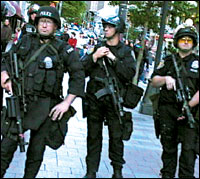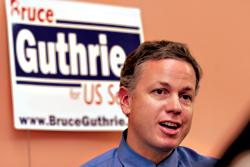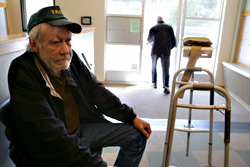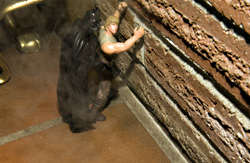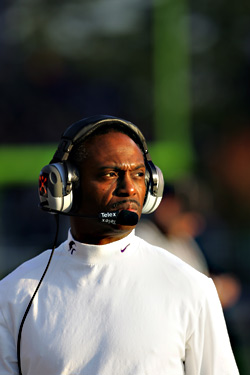Protesters gathered in downtown Seattle on June 2 to call attention to the seemingly secretive Law Enforcement Intelligence Unit (LEIU), which was holding a conference in town, and to make noise about what they see as creeping police statism in America. What protesters got, in two instances, was overkill by law enforcement that many say proved their point.
In one case, an activist videotaped a Seattle police officer toting a machine gun at the initially peaceful demonstrationan object no one Seattle Weekly talked to can remember seeing at recent Seattle protests. In the other case, a protester suffered a head injury, allegedly at the hands of Seattle police officers, and says she did not get sufficient medical attention.
IN RECENT YEARS, police around the country have turned to the AR-15 family of semiautomatic assault rifles, largely as a reaction to an infamous North Hollywood, Calif., bank robbery, when the would-be robbers used assault weapons to pin down cops who were armed with little more than handguns and shotguns. The AR-15 is the civilian version of the military’s fully automatic M-16. It’s an accurate, reliable weapon, with a much greater range than service pistols, which lose much of their accuracy beyond 25 yards. Seattle police have about 100 AR-15s and issue them to officers with special training; the weapons were first deployed in 1998.
So why would a Seattle police officer have an assault rifle at a street demonstration involving 500 protesters? Did police have intelligence about an armed person in the crowd? Why have one at this event when assault rifles have not been visible at protests of the past?
Jim Pugel, an assistant chief of police, says the weapons have, in fact, been at protests for several years. “It’s not a new policy. They’ve always been around,” usually out of sight, says Pugel. The AR-15 is necessary on the scene in case a weapon appears in the crowd or if there is an armed threat against a police officer, he says. There was no specific intelligence that called for the AR-15-toting SWAT sergeant to be more visible at the June 2 protest, and Pugel doesn’t expect to see the weapon play a very visible role at future protests. “You’re not going to see 20 officers in crowd control with these darn things,” he says.
For its part, Mayor Greg Nickels’ office initially responded with laughter when asked to comment on the presence of the AR-15 at the protest. “I’m not going to have the mayor comment on a police operational matter,” said Marianne Bichsel, a spokesperson for the mayor’s office.
When it was pointed out that a cop carrying such a weapon at a lawful gathering was a rather potent symbol of the very thing protesters allegean increasing militarization of policeBichsel questioned whether there had even been an officer carrying an assault rifle. Seattle Weekly e-mailed her a still picture from video shot by an activist, lawyer Paul Richmond, which clearly shows an officer holding an AR-15. Bichsel later amended her statement to say that Nickels was “very pleased” with how police handled the protest, citing flag burnings, among other things, as justification for the police’s forceful response. (Flag burning is constitutionally protected free speech.)
FEW OTHERS ARE quite so sanguine. “That’s a big problem, police carrying machine guns,” says City Council member Nick Licata, who plans to write police Chief Gil Kerlikowske about the matter. Says Larry Gossett, a King County Council member: “It’s absurd and uncalled for. Whoever is responsible for making that decision to send that kind of armory out onto the streets needs to be held accountable.”
Don van Blaricom, former police chief of Bellevue, says he’s puzzled as to why police would turn out with an assault rifle at a protest. “That’s certainly not a crowd-control weapon,” says van Blaricom, who now is a law-enforcement consultant. “It’s certainly not something you use on crowds. You’d want some intelligence to indicate persons in the crowd are likely to be armed, or I don’t know why you’d use it.”
Jackie Helfgott, an associate professor of criminal justice at Seattle University, says that, on one level, she can understand why police would turn out with an assault rifle if they were concerned about a repeat of Seattle’s massive 1999 World Trade Organization protest or the rowdy Mardi Gras incident of 2001, in which one person was beaten to death. Indeed, the June 2 protest got rowdy (who’s to blame is a matter of debate), but police had no need for bullets. And Helfgott has her doubts about displaying such firepower. “It adds this element of danger and raises this question: Is this a necessary display of force in a community?” Helfgott says.
Also searching for answers is Laurel Smith, 21, an organizer with the International Longshore and Warehouse Union in Olympia. She was at the June 2 protest and would like to know why, as she alleges, she suffered a head injury at the hands of police and, later, while in a confused daze, was discharged from jail.
Around 8:30 p.m. that evening, police opened up on protesters with a fusillade of pepper spray and nonlethal grenades in front of the Red Lion Hotel on Fifth Avenue. Soon after, cops pushed protesters away from the hotel to Union Street.
Somewhere in the melee that ensued, Seattle police allege that Smith approached an officer and spit on his safety glasses and left arm, according to a police incident report. Smith was taken to the ground, the report says, but tucked her hands under her torso. An officer was able to extract them. Smith was arrested and charged with assault and obstructing a public-safety officer, both misdemeanors, and transported to the King County Jail.
Smith also was pepper-sprayed, she says. She declined to answer questions about circumstances surrounding her arrest except to say, “No provocation on my part deserved what happened to me.”
What makes this arrest unusual is that Smith wound up with a head injury and contusions to her skull, according to medical records. Smith, who says she’s never been arrested before, says that police repeatedly slammed her head against the pavement while placing her under arrest and that she briefly blacked out. She says she suffered a concussion as a result and bled from her forehead. At the jail, she says she was not examined by a nurse until several hours after she was bookedand only after she made repeated demands for medical attention. The nurse, she says, told her she didn’t have a concussion and that she should take some aspirin.
At 3:30 a.m., Smith was released from jail. She says she spent the next several hours wandering around downtown and Capitol Hill in what she calls a concussed daze. When she later returned to Olympia, she went to the emergency room at Capital Medical Center, where Constance Vasek, an emergency-room physician, examined her. In her report, Vasek wrote that Smith had a “closed” head injury, multiple contusions, and several scrapes elsewhere on her body. Vasek attributed the head injury to a blow from a police baton.
Seattle police Capt. Mike Sanford, incident commander at the protest, said he had no information about how Smith could have been injured. Typically, when police use force in making an arrest, a supervising sergeant fills out a use-of-force report. Sanford says no report was filed in Smith’s case and that, based on what he knew, the level of force used on Smith was “typical.”
Parker McLaughlin, a friend of Smith’s who witnessed her arrest, says that he saw police dragging her by her ankles along the street.
HOW MUCH CARE Smith received at the King County Jail is not clear. Jail officials insist that everyone gets standard medical screening before being placed in a cell. If they require further attention, a nurse sees them. “That absolutely did not happen,” says Smith. “I was taken directly to a cell. Other women were making a fuss over me, saying, ‘There’s something wrong with that girl in the cell.'”
Citing confidentiality laws, Bette Pine, interim director of corrections health care for King County, wouldn’t answer questions about what examination Smith received or how one of her nurses missed what was later diagnosed as a head injury.
Smith was to appear in King County Municipal Court on Tuesday, June 17.
